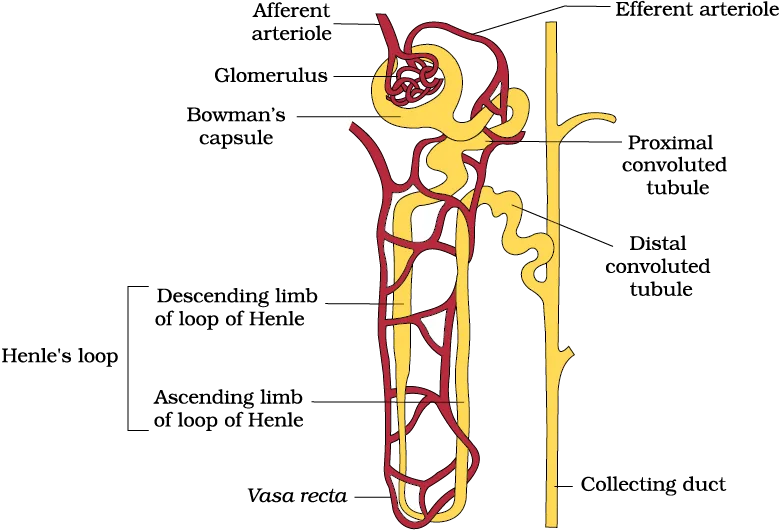The nephron is the functional and structural unit of the kidney. Each human kidney contains about 1 to 1.5 million nephrons, and each nephron is responsible for the filtration of blood and formation of urine.
Understanding the structure and function of each part of a nephron is crucial for exams like NEET, UPSC, SSC, RRB NTPC, and other state PSCs, as questions are frequently asked from this topic.
Overview of Nephron
A nephron is composed of two major parts:
- Renal Corpuscle – includes the Glomerulus and Bowman’s capsule.
- Renal Tubule – includes the Proximal Convoluted Tubule, Loop of Henle (descending and ascending limbs), Distal Convoluted Tubule (not labeled in the image), and Collecting Duct.
Let’s explore the function of each part shown in the image.
Afferent Arteriole
◾ Function:
🔺Brings oxygenated blood into the glomerulus from the renal artery.
🔹It has a wider lumen than the efferent arteriole, which creates pressure for filtration.
✅ Glomerulus
◾ Function:
🔺Acts as a filter for blood.
🔹High-pressure capillary network where ultrafiltration occurs.
🔺Filters water, glucose, amino acids, salts, and urea out of the blood plasma.
🔹Large molecules like proteins and blood cells remain in the blood.

Bowman’s Capsule
◾ Function:
🔺Cup-shaped structure that surrounds the glomerulus.
🔹Receives the filtrate (glomerular filtrate) produced in the glomerulus.
🔺Passes filtrate into the renal tubule for further processing.
Efferent Arteriole
◾ Function:
🔺Carries filtered blood away from the glomerulus.
🔹It is narrower than the afferent arteriole, helping maintain pressure for filtration.
🔺Supplies blood to the peritubular capillaries and vasa recta.
Proximal Convoluted Tubule (PCT)
◾ Function:
🔺Main site of reabsorption of essential substances.
🔹Around 65–70% of water and sodium, glucose, amino acids, and vitamins are reabsorbed here.
🔺Also involved in the secretion of substances like hydrogen ions, creatinine, and drugs.
🔹Maintains the pH of blood through selective ion exchange.
Descending Limb of Loop of Henle
◾ Function:
🔺Permeable to water but impermeable to salts.
🔹Water is reabsorbed into the vasa recta due to the hypertonic medulla.
🔺Concentrates the filtrate as it moves down the loop.
Ascending Limb of Loop of Henle
◾ Function:
🔺Impermeable to water but permeable to salts (Na⁺, K⁺, Cl⁻).
🔹Actively transports salts out of the filtrate, which helps in maintaining the osmotic gradient.
🔺Dilutes the filtrate as it ascends.
Vasa Recta
◾ Function:
🔺Network of capillaries that runs parallel to the Loop of Henle.
🔹Helps in maintaining the counter-current exchange system for urine concentration.
🔺Absorbs water and salts reabsorbed from the loop and collecting ducts.
🔹Maintains medullary concentration gradient.
Collecting Duct
◾ Function:
🔺Final site for water and ion reabsorption, regulated by hormones (e.g., ADH).
🔹Receives filtrate from multiple nephrons.
🔺Controls the final concentration and volume of urine.
🔹Also allows some secretion of potassium and hydrogen ions.
To stay updated with the latest GK and Current Affairs infographics, follow our official Instagram and Facebook page and prepare for exams easily.
Summary Table: Nephron Parts & Their Functions
| Nephron Part | Main Function |
|---|---|
| Afferent Arteriole | Brings blood to the glomerulus |
| Glomerulus | Filters blood (ultrafiltration) |
| Bowman’s Capsule | Collects glomerular filtrate |
| Efferent Arteriole | Carries filtered blood away |
| Proximal Convoluted Tubule | Reabsorption & secretion |
| Descending Limb of Loop of Henle | Water reabsorption (concentrates filtrate) |
| Ascending Limb of Loop of Henle | Salt reabsorption (dilutes filtrate) |
| Vasa Recta | Maintains osmotic gradient via counter-current mechanism |
| Collecting Duct | Regulates water & salt reabsorption; forms final urine |
Important Terms for Exams
◾ Ultrafiltration:
🔹Process by which blood is filtered under high pressure in the glomerulus.
◾ Selective Reabsorption:
🔹Essential substances like glucose and amino acids are reabsorbed back into the blood from PCT.
◾ Counter-Current Mechanism:
🔹The opposite flow of filtrate in the Loop of Henle and blood in the vasa recta helps in urine concentration.
◾ Antidiuretic Hormone (ADH):
🔹Increases water reabsorption in the collecting duct to conserve water.
Exam Tips
✅ Label-based diagram questions frequently appear in NEET, SSC CGL, and State PSCs. Practice this diagram with proper labeling.
✅ Direct one-liner questions like:
- Which part of the nephron is responsible for ultrafiltration?
- What is the function of the ascending limb of the loop of Henle?
- Where is the counter-current mechanism active?
✅ Conceptual MCQs from NEET often involve hormone action, permeability, and urine concentration processes.
Frequently Asked Questions (FAQs)
Q1. What is the first step in urine formation?
→ Ultrafiltration in the glomerulus.
Q2. Which part of nephron reabsorbs maximum water?
→ Proximal Convoluted Tubule (PCT).
Q3. Where does hormone ADH act in nephron?
→ On the Collecting Duct to increase water reabsorption.
Q4. What is the role of vasa recta?
→ Maintains osmotic gradient via counter-current exchange.
Q5. Which part of the Loop of Henle is permeable to water?
→ Descending limb.
Conclusion
Each part of the nephron plays a specialized and vital role in the formation of urine and maintaining the body’s internal environment. A clear understanding of these structures and their functions is not only important for academic learning but also critical for success in various competitive exams.
Keep revising these concepts with diagrams and practice one-liners for better retention!
Explore More on Biology
List of Month-wise State Government Schemes and Campaigns 2025
President Droupadi Murmu in News 2025: Month-wise Current Affairs
Recently Appointed Brand Ambassadors List 2025: Complete Updates
List of Recent Appointments in India and World 2025: Current Affairs
Latest Books and Authors Current Affairs 2025 for Competitive Exams: Full List







